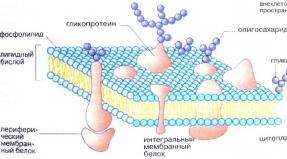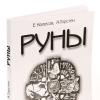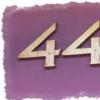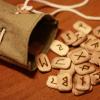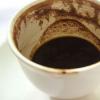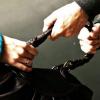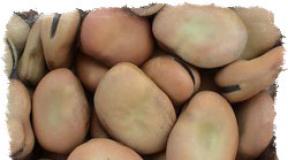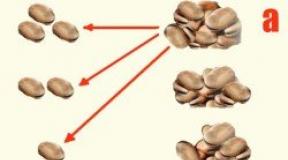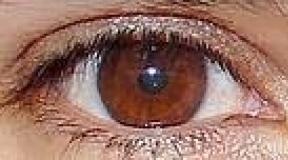Cross of St. Constantine meaning. The history of the development of the cross, the form of the Orthodox cross. Cross round "nahlebnaya"
Cross of Constantine

Magic seal with the symbol "Chi-Rho" (Agrippa, 1533)
The Cross of Constantine is a monogram known as "Khi-Rho" ("chi" and "ro" are the first two letters of Christ's name in Greek). The legend says that the emperor Constantine saw this cross in the sky on the way to Rome, along with the cross he saw the inscription “Conquer this”. According to another legend, he saw the cross in a dream the night before the battle and heard a voice: “With this sign you will win”). It is said that it was this prediction that converted Constantine to Christianity. And the monogram became the first generally accepted symbol of Christianity - as a sign of victory and salvation.
Rosicrucian cross

Cross with a rose (Rosicrucian)
Another name is the cross of the rose (five-petal). Emblem of the Rosicrucian Order. Symbol of harmony, center, heart. The rose and the cross also symbolize the Resurrection and Atonement of Christ. This sign is understood as the divine light of the Universe (rose) and the earthly world of suffering (cross), as the feminine and masculine, material and spiritual, spiritual and sensual love. The cross with a rose is a symbol of the initiate, who, thanks to the work on himself, has managed to develop in himself love, life-giving and transforming matter.
Masonic cross

Masonic cross (cross in a circle)
The Masonic cross is a cross inscribed in a circle. It means a holy place and a cosmic center. The four dimensions of space in the celestial circle symbolize the totality that includes the Great Spirit. This cross represents the Cosmic Tree extending horizontally over the Earth and touching the Heavens through the vertical central axis. Such a cross was either made in stone or depicted on the walls of Roman Gothic temples, symbolizing their sanctification.
Pacifist Cross

Pacifist cross (peace cross)
This symbol was designed by Gerald Holtom in 1958 for the then emerging movement for nuclear disarmament. To develop the symbol, he used the semaphore alphabet: he made a cross from its symbols - for "N" (nuclear, nuclear) and "D" (disarmament, disarmament) - and placed them in a circle, which symbolized a global agreement. Soon this cross became one of the most common signs of the 60s of the twentieth century, symbolizing both peace and anarchy.
images of time
The wise turn years into months, months into weeks, weeks into days.
Paracelsus

Everything is perishable in this world.
The image of inexorable time is the road. The symbol of time is sand flowing through the fingers. Attributes of measured time - a clock, a burning candle; it is a symbol of the elusiveness of the present moment.
In the pantheon of gods of almost all ancient cultures, there is also the god of Time.
Abraxas

Abraxas - a symbol of time (gnostic gem)
Abraxas is the personification of the divine cycles of the solar year. This is the mystical image of the Supreme Being, the highest of the seven. It consists of five emanations (radiations): Nus (Mind), Logos (Word), Phronesis (Reason), Sophia (Wisdom), Dynamis (Power). The human body in the image represents God. The two serpent-supports emerging from it are Nus and Logos (intuition and quick understanding). The head of a rooster means foresight and vigilance (mind). Two hands hold the symbols of Sophia and Dynamis: the armor of wisdom and the whip of power.
Kalachakra

Namchu-vanden - emblem of Kalachakra
Kalachakra - literally "wheel of time", "course of time". Secret Doctrine in Vajrayana Buddhism. An astrological and astronomical system that entered Tibet from India. Kalachakra introduces the concept of the cyclical nature of time with periods of 12 and 60 years (Tibetan calendar). According to legend, the Kalachakra teaching was given by the Buddha Shakyamuni. According to other sources, this teaching was brought to Tibet by Pitop, or the Great Kalachakrapada, who, having miraculously found himself in Shambhala, was initiated there by the king of Kalki into the teachings of Kalachakra.
Kronos

Kronos (Rom. Saturn), XV century
The ancient Greek symbol of time - the titan Kronos - became the ancestor of many words in Russian (the particle “chrono” is part of compound words indicating their relationship to time): chronic, chronology, chronometer, etc.
Kronos (Rom. Saturn) - the god of Time, in the form of a fading autumn or the departing Sun, sometimes, along with his sickle, also has a hood, which symbolizes invisibility, death and retreat. Since the hood covers the head, it also signifies thought and spirit.
Nowadays, different people come to the Church. Many do not understand church symbols. This is not surprising, because the teaching of Christ has more than two thousand years. In Orthodoxy there are many mysterious symbols. The culture and perception of the world has changed. Only the word of God remained unchanged.
Cross symbol
Some signs and symbols of different eras remained only in the history of the Church. Others live on icons and in books. Turning to the power of the Life-Giving Cross of the Lord has been and remains a great defense for every person. It is known that the sign of the cross stops the demonic influence: the devil and his servants cannot endure the correct cross, therefore they often try to mock him (this is the origin of the satanic symbols of the inverted cross).
The cross is an important symbol for every Orthodox Christian. This is the power of God, visibly staying with us, on our body, from the very moment of Baptism. Therefore, it is especially important to have an Orthodox Cross at home, correctly depicted on an icon consecrated and acquired in the church, or made in metal.
On the Orthodox Cross, you can often see a number of inscriptions and additional images that seem mysterious to the uninitiated: NIKA, a skull, IS XC QI, in a living church tradition.
Often we wear a pectoral cross unconsciously or for the sake of fashion, tradition, without thinking about its strength. On the one hand, this is not true. On the other hand, in any case, we protect ourselves with the cross.

Emperor Constantine the Great and the Cross
Back in the 4th century, one of the greatest miracles in history happened: the emperor of Byzantium, Constantine, learned about Christianity and, unlike his royal predecessors, did not start persecuting the disciples of Christ, but turned in his heart to the Lord Jesus. And before one of the terrible battles, after a sacred prayer, the emperor saw a shining Cross in the sky above the battlefield and heard God's voice: "By this, conquer!" - that is, "you will overcome with the help of this sign." So the Cross became the military banner of the whole Empire, and under the sign of the Cross, Byzantium flourished for many centuries. Constantine, however, eventually converted to Christianity and was called the Great, and after death he was canonized as a holy king equal to the apostles - for his deeds and for his faith.
At the same time, in 326, the mother of Constantine the Great, Queen Elena, found the Cross of Christ, who was looking for it together with priests and bishops, among other crosses - instruments of execution - on Mount Golgotha, where the Lord was crucified. She was baptized, having heard the sermon of the disciples of Christ , the mother of Emperor Constantine the First, Empress Elena, was baptized. She raised her royal son to be an honest and righteous man. After Baptism, Elena wanted to find the Cross on which the Lord Jesus Christ was crucified and which was buried on Mount Golgotha. She understood that the Cross would unite Christians and become the first great shrine of Christianity.
As soon as the Cross was raised from under the ground, the deceased was resurrected, who was carried past in a funeral procession: therefore, the Cross of Christ immediately began to be called Life-Giving. Since then, pectoral crosses of various shapes and from various materials have been worn by all Christians.

History of Chrysma and the Cross
Many people ask what is Christianity. This is the monogram of the word "Christ", consisting of intertwined letters X and R. In fact, chrism and the Constantine Cross are one and the same, but the Constantine Cross has the letters Alpha and Omega next to it, referring to the Apocalypse.
The Christogram was already used in places where the early Christians met. Early samples of it were found in the catacombs, where, as is known, the apostolic communities were hiding, as well as on sarcophagi and monuments. Further, the Christogram appeared in the temples newly built after the persecution. This symbol was actively used along with others in the interior.
The Cross seen by Constantine, according to legend, was a christogram - a monogram of the letters "X" and "P", woven in the form of a Cross. It became the state seal of Constantine himself and his successors, the Christian emperors of Byzantium. The prism also became a military labarum symbol, which was very important for the empire. It was a standard of a special kind. Previously, in its place was a Roman eagle.

Drawings on the Cross and next to it
Despite the fact that it is known from the Gospel and the testimonies of historians what the Cross of Christ looked like, symbolically it is depicted in different ways.
In the Catholic tradition, the Cross is depicted with only one large crossbar, succinctly. However, in Orthodoxy, the Cross is traditionally depicted as eight-pointed, with additional lower and upper crossbars. This is a reproduction of the famous and real historically existing Cross of Jesus Christ.
The topmost bar is the plaque on the Cross of Christ with the inscription YINGI. This inscription is known from the Gospel and means "Jesus the Nazarene King of the Jews."
The lowest, oblique crossbar is a foothold, traditionally placed on crosses. Its symbolic meaning is a reminder of the story of two thieves crucified to the right and left of Christ. The right end of the crossbar is raised in remembrance of the pious thief who repented of his sins on the cross, who considered himself unworthy of paradise, and who was the first to enter the Kingdom of Heaven with Christ. The second end is omitted, in remembrance of the second robber who cursed God. This story is evidence that the very death of each person can change his afterlife.
The image on the left is a spear, on the right is a cane - the instruments of execution of the Savior. With a spear, a Roman soldier pierced the already deceased Christ in order to understand whether He had died, and “blood and water flowed out of His side.” A sponge with vinegar is planted on a cane, one of the soldiers gave it to Christ.
Below is a skull - this is the head of Adam, that is, the burial of the first person is symbolically depicted. According to legend, it was near Golgotha that he was buried in ancient times.
Interpretations of Holy Scripture thus explain the meaning of the Sacrament of the Savior's death on the Cross. Once Adam ate the sweet fruit of the tree of the knowledge of good and evil, but only found death for the whole race of people. And the Lord drank the bitterness of vinegar from the reed in order to return people from the bitter eternal death to the sweetness of life with God, so that the bitterness of sin would not have power over people. The Lord accepted death, conquered it, and gave the possibility of eternal life to those who believe in Him and keep His commandments. Christ was crucified where Adam was buried, so that life would win exactly where death, which once conquered the first man, came.

Symbols accompanying the Constantine Cross
The first Christian symbols appeared in the conditions of persecution of the disciples of Christ. The apostles themselves were killed for preaching the doctrine of goodness and freedom alien to paganism. Therefore, a certain cryptography was used. Iconography has not yet appeared - its heyday began only with the permission of the free Christian religion. Christ was depicted only allegorically. The first Christian signs and images were
The Good Shepherd is an image of a young shepherd, often with a sheep on his shoulders, symbolizing Christ the Savior, who shepherds Christians like his flock, taking care of believers. This is a reminder of the parable told by Christ: the shepherd will take care of even one lost sheep (about the sinner).
The Lamb - that is, the Lamb, meaning Christ Himself, Who "like a lamb against his shearer was dumb" and offered Himself as a sacrifice for the sins of people.
One of the first images of the Lord was the image of a fish, by which some communities of the first Christians recognized each other. The fact is that the first letters of the Greek translation of the phrase “Jesus Christ the Son of God the Savior” add up to the Greek word “ichthus”, fish. This symbol was close to the apostles, many of whom were fishermen, and the first Christians, most of whom were ordinary people.
The anchor is a symbol of hope and faith.
The Communion cup and the spear with which the bread is cut for conversion into the Body of Christ, and the bread itself. The symbolism of Communion also includes the image of a bunch of grapes or a vine.
The triangle is a sign of the Holy Trinity (Father, Son and Holy Spirit). He is surrounded by radiance as a sign of the holiness of God. Another sign is usually inscribed in it: the All-Seeing Eye, the sign of God's Omniscience.
The dove is a messenger of goodness and peace. Now it is already a global symbol of peace. He is depicted with an olive branch in his beak: according to the Bible, the dove announced to the forefather Noah about the end of the Flood.
The eight-pointed star of Christ is also an early Christian symbolism. Initially, the eight-pointed star meant Christmas or Bethlehem. It is historically attested that at the time of the birth of the Lord Jesus Christ there was a certain new star in the sky, a celestial phenomenon - perhaps a comet. However, it lit up in heaven as a sign of the coming into earthly life of the Messiah, Christ the Savior. The star of Bethlehem, according to the Gospel, showed the way to the Magi, who came thanks to it to worship the Son of God and bring their gifts to Him. The star of Bethlehem is an elongated rhombus inscribed in a square, this is how its eight rays are formed. Such a sign was theologically interpreted on the icon “The Savior in Strength”, becoming a sign of the power of Christ - it is no coincidence that the star of Bethlehem became His star. The octogram can be seen on many European and Russian houses around Christmas.
A star with five rays is one of the ancient symbols. The pentagram is associated with the Pentateuch, called the Torah in Judaism, the biblical books written by the prophet Moses. They are also revered by all Christians. The five points of the star also mean the five wounds of the Lord Jesus on the Cross. The associations of the star and the Lord are based on the words of the Book of Revelation, where Christ says: "I am the offspring and root of David, the morning star and the bright one."
May the Lord bless you with His grace!
Any religious tradition has its own set of spiritual symbols. They can both play the role of brand logos and carry a deep sacred and mystical meaning. Christianity is no exception to this rule. With all its distrust (in the orthodox current) to various kinds of symbolism and esotericism, it has developed its own, sometimes ornate and multifaceted symbols. One of these signs, namely the so-called cross of Tsar Constantine, will be discussed in this article.
The legend of the origin of the cross of Constantine
Strictly speaking, this sign is not a cross. It would be correct to call it a monogram - a symbol formed from several letters, displaying the image of a specific character of religious doctrine - Jesus Christ. According to Christian tradition, the Constantine cross played an extremely important role in the history of the church. In strength and significance, it is second only to the usual cross.

Indeed, having won a brilliant victory in the battle, Constantine made this sign the basis for a personal seal and a symbol of his state. At the same time, he internally became an adherent of the Christian faith. And although he remained unbaptized for a long time, having established his power, he forever stopped the persecution and persecution of Christians in the Roman Empire. This Constantine cross is the current Christogram used in churches. Its other name is chrism.
Whether this legend reflects historical reality or not, it makes it clear why Christians so cherish and value this sign so much. He turned the course of history by turning the emperor - the supreme pagan priest - to the side of the Christians, as a result of which a small sect of Jesus' followers became the most numerous religious movement on the planet.
The first mention of the christogram
The first source of information known today that mentions the cross of Constantine the Great is the works of the church historian Lactantius (320). He reproduces the above version of events, with the addition that the apparition was accompanied by a voice which in Greek repeated the Latin inscription.

Another church historian, and also a personal biographer of Constantine - Eusebius, Bishop of Neocaesarea, at different times reported on two versions of the origin of the Christogram. According to the early, she appeared to the future emperor long before 312, when he was in Gaul. However, later he refuses this version, subordinating his description to the generally accepted opinion. At the same time, referring to the personal oral communication of the emperor himself, he clarifies that the symbol that appeared eclipsed the sun and, together with Constantine, this spectacle was observed by the entire army, consisting of forty thousand people.
The third source just presents the testimony of one of those soldiers who took part in the battle at the Milvian bridge and contemplated the cross of Constantine in the sky with his own eyes. His name is Artemy, and his story is aimed at denouncing the emperor Julian the Apostate, who, as you know, renounced Christianity, deciding to revive the pagan institutions in the Roman Empire. Artemy was executed by him.
Origin of the Christogram

Historical research suggests that chrism is of pre-Christian origin and was most likely borrowed and adapted by church leaders for two reasons:
Since Christians were outside the law for a long time, they were forced to conspire and use common pagan symbols, filling them with their own content. In the same way, images of Orpheus, Helios and other gods were popular among Christians. And the Constantine Cross itself is, most likely, an adapted solar symbol of the ancient Chaldeans.
The Greek word "chrestos", meaning "auspicious", could also be graphically represented by the first two letters. Because of this, the symbol was easily Christianized in the circles of the followers of Jesus, who gave it the meaning of "Christ".
One way or another, in pre-Constantine times, several types of Christian monograms and their pagan prototypes are known.

Chrysm Spread
Before the christogram became known as the cross of St. Constantine, it was used primarily in Christian gathering places. The most ancient examples of it were found in the catacombs - underground cemeteries that church members used as places of meetings and services. Funeral monuments and sarcophagi of Christians brought to us similar symbols.
After legalization, this symbol began to be used as a religious sign in newly built churches. On the other hand, it served as an element of artistic design and decor - they decorated bowls, lamps, caskets, etc. In secular circles, as already mentioned, the Christogram was the state seal of Constantine himself and a number of his successors, as well as the official military symbol of the labarum, replacing it with this place is the traditional Roman eagle.
Monogram ιχ
Among other things, the christogram, visually similar to the Russian letter “Ж”, was used in Christian churches already in the 3rd century, that is, long before the accession of Constantine to the throne. There was no letter ρ (ro) in it - instead of it there was ι (iota), meaning "Jesus". It is even possible that this letter later acquired the symbolic form of a shepherd's (ie, episcopal among Christians) wand - a staff with a twisted end. It was he who later became associated with the letter ρ.
Monogram χρ
This version of this symbol is the main and, so to speak, canonical in the Christian church. It is he who is called the "cross of Constantine." His photo is presented below.

About the meaning of chrism
Various mystical groups, both within the milieu and among other currents, have attached great importance to the inner meaning of the Greek letters. It even contains unambiguous references to gematria - a method of searching for a secret meaning through the calculation of numerical correspondences between the letters of words and names. The cross of Constantine can be analyzed in the same way.
The meaning in it is given to the first two letters of the word "Christ". The sum of their numerical values is exactly 700, which was played out in a special way in complex Gnostic theology. Therefore, in an ancient, but little known today tradition, the number 700 acts as a synonym for Christ. And if, for example, we consider the letters of the Christogram separately, we get the following: χ (chi) - means the macrocosm, the whole universe. The numerical value is 100. And ι (iota), on the contrary, denotes the microcosm. Its value is 10. Thus, a clear symbol of the unity of the microcosm and macrocosm is obtained - the relationship of the part and the whole, great in the small. In the case of the later version of chrism, where ι is replaced by ρ, the symbol means divine creation (due to the semantics of the letter ρ). It carries the meaning of creative power, world order, female generative energy.
Related characters
Very often, together with chrism, two more letters of the Greek alphabet are used - α (alpha) and ω (omega), which are the first and last letters of the Greek alphabet and denote the beginning and end of the world, as well as its entire ontological essence contained in intermediate letters. The beginning of this symbolism in Christianity was given by the Bible, or rather a book where the words "I am Alpha and Omega" are put into the mouth of Jesus Christ.
Cross T-shaped "Antonievskiy"
In the southern and eastern parts of the Roman Empire, a tool was used to execute criminals, called the "Egyptian" cross since the time of Moses and resembling the letter "T" in European languages. “The Greek letter T,” wrote Count A.S. Uvarov, “is one of the forms of the cross used for crucifixions” (Christian symbolism, M., 1908, p. 76)
“The number 300, expressed in Greek through the letter T, also served from the time of the Apostles to designate the cross,” says the well-known liturgist Archimandrite Gabriel. “This Greek letter T is found in the inscription of the tomb of the 3rd century, discovered in the catacombs of St. the image of the letter T is found on one carnelian engraved in the 2nd century" (Guide to Liturgy, Tver, 1886, p. 344)
The saint also argues about the same: "The Greek image," Tav "called, which the Angel of the Lord made "sign on forehead"() God's people in Jerusalem, in order to protect them from impending murder, were seen in revelation by the holy prophet Ezekiel. (…)
If we apply the title of Christ to this image at the top in this way, we will immediately see the four-pointed cross of Christ. Therefore, there Ezekiel saw a prototype of a four-pointed cross "(Search, M., 1855, book 2, ch. 24, p. 458).
Thus, "and this monogram, according to the interpretation of St. Justin, served as a sign of the Cross of Christ (...), received such an extensive meaning in symbolism only after the first monogram. (...) In Rome (...) it became commonly used not before 355, but in Gaul - not before the 5th century" (Gr. Uvarov, p. 77).
Cross monogram "sun-shaped"

Already on the coins of the 4th century there is a monogram "I" of Jesus "XP" is "sun-shaped", "For the Lord God as the Scripture teaches, there is a sun" ().
The most famous, "Konstantinovskaya", "the monogram was subjected to some changes: another line or the letter "I" was added, crossing the monogram across" (Archim. Gabriel, p. 344).
This "sun-shaped" cross symbolizes the fulfillment of the prophecy about the all-enlightening and all-conquering power of the Cross of Christ: "And for you who revere my name, the Sun of righteousness will rise and its rays heal,- proclaimed by the Holy Spirit the prophet Malachi, - and you will trample the wicked; for they will be dust under your feet." (4:2-3).
Cross monogram "trident"
When the Savior passed near the Sea of Galilee, He saw fishermen throwing nets into the water, His future disciples. "And he said to them, Follow me, and I will make you fishers of men"(). And later, sitting by the sea, He taught the people with His parables: "The kingdom of heaven is like a net thrown into the sea and seizing every kind of fish"(). “Having recognized the symbolic meaning of the Kingdom of Heaven in shells for fishing,” says the “Christian Symbolism,” we can assume that all the formulas related to the same concept were iconically expressed by these common symbols. The trident used to catch fish, as they now catch with hooks" (Gr. Uvarov, 147).
Thus, the trident monogram of Christ has long meant participation in the Sacrament of Baptism, as being caught in the net of the Kingdom of God. For example, on an ancient monument of the sculptor Eutropius, an inscription is carved, which speaks of his acceptance of baptism and ends with a trident monogram (Gr. Uvarov, p. 99).
Cross monogram "Konstantinovsky"
From church archeology and history it is known that on ancient monuments of writing and architecture there is often a variant of combining the letters "Chi" and "Rho" in the monogram of the holy King Constantine, the God-chosen successor of Christ the Lord on the throne of David.
Only from the 4th century did the constantly depicted cross begin to free itself from the monogram shell, lose its symbolic coloring, approaching its real form, resembling either the letter "I" or the letter "X".
These changes in the image of the cross occurred due to the emergence of Christian statehood, based on its open veneration and glorification.
Cross round "nahlebnaya"
According to an ancient custom, as Horace and Martial testify, Christians cut the baked bread crosswise to make it easier to break it. But long before Jesus Christ, this was a symbolic transformation in the East: the incised cross, dividing the whole into parts, unites those who used them, heals separation.
Such round loaves are depicted, for example, on the inscription of Sintrophion divided into four parts by a cross, and on the tombstone from the cave of St. Lukina divided into six parts by a monogram of the 3rd century.
In direct connection with the Sacrament of Communion, chalices, phelonions and other things depicted bread as a symbol of the Body of Christ, broken for our sins.
The circle itself, before the birth of Christ, was depicted as the idea of immortality and eternity, not yet personified. Now, by faith, we understand that “the Son of God Himself is an endless circle,” according to the word of the saint, “in which all forces converge.”
Catacomb cross, or "sign of victory"
“In the catacombs and in general on ancient monuments, four-pointed crosses are incomparably more common than any other form,” Archimandrite Gabriel notes. This image of the cross has become especially important for Christians since God Himself showed the sign of the four-pointed cross in heaven "(Rukov ., p. 345).
The well-known historian Eusebius Pamphal narrates in detail how all this happened in his Book One on the Life of the Blessed Tsar Constantine.
“Once, at noon, when the sun was already beginning to lean toward the west,” the Tsar said, “I saw with my own eyes the sign of the cross, composed of light and lying on the sun, with the inscription “Conquer this!” This spectacle seized both him and himself with horror. and all the army that followed him and continued to contemplate the miracle that appeared (ch. 28).
It was on the 28th day of October 312, when Constantine marched with his army against Maxentius, who was imprisoned in Rome. This miraculous appearance of the cross in broad daylight has also been witnessed by many modern writers from the words of eyewitnesses.
Particularly important is the testimony of the confessor Artemius before Julian the Apostate, to whom Artemius said during interrogation:
“Christ called Constantine from above when he waged war against Maxentius, showing him at noon the sign of the cross, shining radiantly over the sun and star-shaped Roman letters predicting victory in the war for him. Being there ourselves, we saw His sign and read the letters, saw him and everything army: there are many witnesses to this in your army, if only you want to ask them "(ch. 29).
"By the power of God, the holy Emperor Constantine won a brilliant victory over the tyrant Maxentius, who did impious and villainous deeds in Rome" (ch. 39).
Thus, the cross, which used to be an instrument of shameful execution among the pagans, became under the Emperor a sign of victory - the triumph of Christianity over paganism and the subject of the deepest reverence.
For example, according to the short stories of the holy Emperor Justinian, such crosses were supposed to be placed on contracts and meant a signature "worthy of all confidence" (book 73, ch. 8). The acts (decisions) of the Councils were also fastened with the image of the cross. One of the imperial decrees says: "we command every conciliar act, which is approved by the sign of the holy Cross of Christ, to be preserved and so be as it is."
In general, this form of the cross is most often used in ornaments for decorating temples, icons, priestly vestments and other church utensils.
The cross in Russia is "patriarchal", or in the West "Lorensky"
The fact proving the use of the so-called "patriarchal cross" since the middle of the last millennium is confirmed by numerous data from the field of church archeology. It was this form of the six-pointed cross that was depicted on the seal of the governor of the Byzantine Emperor in the city of Korsun.
The same type of cross was also widely used in the West under the name "Lorenskoy".
For an example from the Russian tradition, let us point out at least the large copper cross of St. Avraamy of Rostov of the 18th century, stored in the Andrei Rublev Museum of Old Russian Art, cast according to iconographic samples of the 11th century.
Four-pointed cross, or Latin "immissa"
The textbook "The Temple of God and Church Services" reports that "a strong motivation for honoring the direct image of the cross, and not the monogram, was the acquisition of the Precious and Life-Giving Cross by the mother of the holy Tsar Constantine, Equal-to-the-Apostles Elena. As the direct image of the cross spreads, it gradually takes on the form of the Crucifixion "(SP, 1912, p. 46).
In the West, the most common now is the "immissa" cross, which the schismatics - admirers of imaginary antiquity - scornfully call (for some reason in Polish) "kryzh in Latin" or "Rymsky", which means - the Roman cross. These detractors of the four-pointed cross and devout admirers of the osmikonomy, apparently, need to be reminded that, according to the Gospel, the execution of the cross was spread throughout the Empire precisely by the Romans and, of course, was considered Roman.
“And not according to the number of trees, not according to the number of ends, the Cross of Christ is revered by us, but according to Christ Himself, with Whose holy blood it was stained,” St. Demetrius of Rostov denounced schismatic reasoning. “And, showing miraculous power, any cross does not act by itself, but by the power of Christ crucified on him and by the invocation of His holy name" (Search, book 2, ch. 24).
Accepted by the Universal Church for use, the "Canon of the Holy Cross" - the creation of the saint - sings of the Divine power of the Cross, containing everything heavenly, earthly and underworld: "The all-honorable Cross, the four-pointed power, the splendor of the Apostle" (song 1), "Behold the four-pointed Cross, having height , depth and breadth" (song 4).
Starting from the 3rd century, when such crosses first appeared in the Roman catacombs, the entire Orthodox East still uses this form of the cross as equal to all others.
Cross "papal"
This form of the cross was most often used in the hierarchical and papal services of the Roman Church in the 13th-15th centuries and therefore was called the "papal cross".
To the question about the foot, depicted at right angles to the cross, we will answer with the words of St. Demetrius of Rostov, who said: "I kiss the foot of the cross, if it is oblique, if not oblique, and the custom of the cross-makers and cross-writers, as consistent with the church, I do not dispute, I condescend" (Search, book 2, chapter 24).
Six-pointed cross "Russian Orthodox"
The question of the reason for the inscription of the lower crossbar tilted is quite convincingly explained by the liturgical text of the 9th hour of the service to the Cross of the Lord: “In the midst of two thieves, the measure of righteousness, finding Your Cross: the first I am brought down to hell with the burden of blasphemy, while the other I am relieved from sins to the knowledge of theology”. In other words, both on Golgotha for two thieves, and in life for each person, the cross serves as a measure, as if the scales of his inner state.
To one thief who is brought down to hell "burden of blasphemy", pronounced by him on Christ, he became, as it were, the crossbar of the scales, bowed down under this terrible weight; another thief, freed by repentance and the words of the Savior: "today you will be with me in paradise"(), the cross elevates to the Kingdom of Heaven.
This form of the cross in Russia has been used since ancient times: for example, the worship cross, arranged in 1161 by the Monk Euphrosyne, Princess of Polotsk, was six-pointed.
The six-pointed Orthodox cross, along with others, was used in Russian heraldry: for example, on the coat of arms of the Kherson province, as explained in the "Russian armorial" (p. 193), a "silver Russian cross" is depicted.
Eight-pointedness - most corresponds to the historically reliable form of the cross, on which Christ was already crucified, as the saint testifies, Saint Justin the Philosopher and others. “And when Christ the Lord carried the cross on His shoulders, then the cross was still four-pointed; because there was still no title or foot on it. (...) There was no foot, because Christ was not yet raised on the cross and the soldiers, not knowing where the feet of Christ would reach, they did not attach the footstool, having finished it already at Golgotha,” St. Demetrius of Rostov denounced the schismatics (Search, book 2, ch. 24). There was also no title on the cross before the crucifixion of Christ, because, as the Gospel reports, at first "crucified him"() and then only "Pilate wrote the inscription and placed(by your order) on the cross"(). It was at first divided by lot "His clothes" warriors, "they crucified him"(), and only then "They placed over His head an inscription signifying His guilt: This is Jesus, the King of the Jews" ().
So, the four-pointed Cross of Christ, carried to Golgotha, which everyone who has fallen into the demonic schism calls the seal of the Antichrist, is still called in the Holy Gospel "His cross" (, , , ), that is, in the same way as with the tablet and footstool after crucifixes (). In Russia, the cross of this form was used more often than others.
This form of the cross is quite often found on the icons of northern painting, for example, the Pskov school of the 15th century: the image of St. Paraskeva Pyatnitsa with life is from the Historical Museum, or the image of St. Demetrius of Thessalonica - from the Russian; or the Moscow school: "Crucifixion" by Dionysius - from the Tretyakov Gallery, dated 1500.
We also see the seven-pointed cross on the domes of Russian churches: let us cite, for example, the wooden Ilyinsky Church of 1786 in the village of Vazentsy (Holy Russia, St. Petersburg, 1993, ill. 129), or we can see it above the entrance to the Cathedral of the Resurrection New Jerusalem Monastery, built.
At one time, theologians heatedly discussed the question of what kind of mystical and dogmatic meaning does the footstool have as part of the redemptive Cross?
The fact is that the Old Testament priesthood received, so to speak, the opportunity to make sacrifices (as one of the conditions) thanks to "golden footstool attached to the throne"(Chron. 9:18), which, as it is still with us Christians, according to God's ordinance, was sanctified through chrismation: "And anoint them," said the Lord, "the altar of burnt offering and all its utensils, (...) and its bases. ().
Thus, the foot of the cross is that part of the New Testament altar, which mystically points to the priestly ministry of the Savior of the world, who voluntarily paid with His death for the sins of others: for the Son of God "Our sins He Himself bore in His body on the tree" ("sacrifice himself"() and thus, "being made high priest forever"(), established in His face "priesthood is everlasting" ().
And so it is stated in the "Orthodox Confession of the Eastern Patriarchs": "On the cross, He fulfilled the office of the Priest, offering Himself as a sacrifice to God and the Father for the redemption of the human race" (M., 1900, p. 38).
But let's not confuse the foot of the Holy Cross, which reveals to us one of its mysterious sides, with the other two feet from the Holy Scriptures, - explains St. Dmitry Rostovsky.
"David says, "Exalt the Lord our God, and worship at His footstool; holy It"(). And Isaiah says on behalf of Christ: (), - explains St. Demetrius of Rostov. There is a footstool that is commanded to worship, and there is a footstool that is not commanded to be worshiped. God says in Isaiah's prophecy: "Heaven is my throne, and the earth is my footstool"(): this foot - the earth no one should worship, but only God, its Creator. And it is also written in the psalms: "The Lord (Father) said to my Lord (Son), Sit at my right hand until I make your enemies your footstool"(Pis. 109:1). And this footstool of God, the enemies of God, who wants to worship? What footstool does David command to worship?" (Search, book 2, ch. 24).
To this question the very word of God on behalf of the Savior answers: "and when I am lifted up from the earth"() - "from my footstool" (), then "I will glorify my footstool" () — "foot of the altar"() of the New Testament - the Holy Cross, which casts down, as we confess, Lord, "Your enemies for Your footstool"(), and therefore "worship the footHis; holy it!" (), "a footstool attached to a throne" ().
Cross "crown of thorns"
The image of a cross with a crown of thorns has been used for many centuries by various peoples who have adopted Christianity. But instead of numerous examples from the ancient Greco-Roman tradition, we will give several cases of its use in later times according to the sources that were at hand. A cross with a crown of thorns can be seen on the pages of an ancient Armenian manuscript books the period of the Cilician kingdom (Matenadaran, M., 1991, p. 100); on the icon"Glorification of the Cross" of the XII century from the Tretyakov Gallery (V. N. Lazarev, Novgorod icon painting, M., 1976, p. 11); on Staritsky copper-cast cross- vest of the XIV century; on the cover"Golgotha" - the monastic contribution of Tsarina Anastasia Romanova in 1557; on silver platter XVI century (Novodevichy Convent, M., 1968, ill. 37), etc.
God told sinning Adam that "Cursed is the earth for you. Thorns and thistles it will grow for you"(). And the new sinless Adam - Jesus Christ - voluntarily took upon himself other people's sins, and death as a consequence of them, and thorny suffering, leading to it along a thorny path.
Christ's Apostles Matthew (27:29), Mark (15:17) and John (19:2) tell that "The soldiers wove a crown of thorns and put it on his head", "and by his stripes we are healed"(). From this it is clear why the wreath has since symbolized victory and reward, starting with the books of the New Testament: "crown of truth" (), "crown of glory" (), "crown of life"( and ).
Cross "gallows"

This form of the cross is very widely used in the decoration of churches, liturgical objects, hierarchal vestments, and in particular, as we can see, bishops' omophorions on the icons of the "three ecumenical teachers".
“If anyone tells you, do you worship the Crucified? You answer with a bright voice and with a cheerful face: I worship and will not stop worshiping. John Chrysostom (Conversation 54, on Matt.).
The cross of any form has an unearthly beauty and life-giving power, and everyone who knows this God's wisdom exclaims with the Apostle: "I (…) I wish to boast (…) only by the cross of our Lord Jesus Christ" ()!
Cross "vine"
"I am the true vine, and my Father is the vinedresser"(). This is how Jesus Christ called himself, the Head of the Church planted by Himself, the only source and conductor of spiritual, holy life for all Orthodox believers, who are members of His body.
"I am the vine and you are the branches; he who abides in me and I in him bears much fruit"(). “These words of the Savior Himself laid the foundation for the symbolism of the vine,” wrote Count A. S. Uvarov in his work “Christian Symbolism”; the main meaning of the vine for Christians was in a symbolic connection with the Sacrament of Communion "(pp. 172 - 173).
Cross "petal"
The variety of forms of the cross has always been recognized by the Church as quite natural. According to the expression of the monk, "a cross of every form is a true cross." The “petal” cross is very often found in church fine art, which, for example, is seen on the omophorion of the saint of the 11th-century mosaic of the Hagia Sophia of Kiev.
“By a variety of sensory signs, we are hierarchically elevated to a uniform union with God,” explains the famous teacher of the Church, the saint. From the visible to the invisible, from the temporal to eternity - such is the path of a person, led by the Church to God through the comprehension of grace-filled symbols. The history of their diversity is inseparable from the history of the salvation of mankind.
Cross "Greek", or Old Russian "korsunchik"
Traditional for Byzantium and the most frequently and widely used form of the so-called "Greek cross". The same cross is considered, as you know, the most ancient "Russian cross", since, according to church Tradition, the holy prince Vladimir brought from Korsun, where he was baptized, just such a cross and installed it on the banks of the Dnieper in Kyiv. A similar four-pointed cross has survived to this day in the Kiev Sophia Cathedral, carved on the marble board of the tomb of Prince Yaroslav, son of St. Vladimir the Equal-to-the-Apostles.
Often, to indicate the universal significance of the Cross of Christ as a microuniverse, the cross is depicted as inscribed in a circle, symbolizing the cosmological sphere of heaven.
Cross "dome" with a crescent
It is not surprising that the question about the cross with a crescent is often asked, since the "dome" is located in the most prominent place of the temple. For example, the domes of the Cathedral of St. Sophia of Vologda, built in 1570, are decorated with such crosses.
Typical of the pre-Mongol period, this form of a domed cross is often found in the Pskov region, once on the dome of the Church of the Assumption of the Virgin in the village of Meletovo, erected in 1461.
In general, the symbolism of an Orthodox church is inexplicable from the point of view of aesthetic (and therefore static) perception, but, on the contrary, it is quite open for understanding precisely in liturgical dynamics, since almost all elements of church symbolism, in different places of worship, assimilate different meanings.
"And a great sign appeared in heaven: a woman clothed with the sun,- says in the Revelation of John the Theologian, - moon under her feet(;1), and patristic wisdom explains: this moon marks the font in which the Church, baptized into Christ, is clothed in Him, in the Sun of truth. The crescent is also the cradle of Bethlehem, which received the Divine Infant Christ; the crescent is the Eucharistic cup in which the Body of Christ is located; the crescent is a church ship, led by Christ the Pilot; the crescent is also the anchor of hope, the gift of the cross of Christ; the crescent moon is also the ancient serpent trampled under the Cross and placed as an enemy of God under the feet of Christ.
Cross "trefoil"
In Russia, this form of the cross is used more often than others for the manufacture of altar crosses. But, however, we can see it on state symbols. "A golden Russian shamrock cross, standing on a silver overturned crescent", as reported in the Russian Heraldry, was depicted on the coat of arms of the Tiflis province.
The golden "shamrock" (Fig. 28_1) is also on the coat of arms of the Orenburg province, on the coat of arms of the city of Troitsk, Penza province, the city of Akhtyrka, Kharkov and the city of Spassk, Tambov provinces, on the coat of arms of the provincial city of Chernigov, etc.
Cross "Maltese", or "St. George"
Patriarch Jacob prophetically honored the Cross when "bowed down in faith, As the Apostle Paul says, on top of his staff"(), "a wand," explains the saint, "which served as an image of the cross" (On holy icons, 3 ate.). That is why today there is a cross above the hilt of the bishop’s baton, “for by the cross,” writes the saint, “we are guided and grazed, we are sealed, we are born and, having mortified the passions, we are drawn to Christ” (ch. 80).
In addition to the usual and widespread church use, this form of the cross, for example, was officially adopted by the Order of St. John of Jerusalem, formed on the island of Malta and openly fought against Freemasonry, which organized, as you know, the murder of the Russian Emperor Pavel Petrovich - the patron of the Maltese. This is how the name "Maltese Cross" appeared.
According to Russian heraldry, some cities had golden "Maltese" crosses on their coats of arms, for example: Zolotonosha, Mirgorod and Zenkov of the Poltava province; Pogar, Bonza and Konotop of the Chernihiv province; Kovel Volynskoy,
Perm and Elizavetpol provinces and others. Pavlovsk St. Petersburg, Vindava Courland, Belozersk Novgorod provinces,
Perm and Elizavetpol provinces and others.
All those who were awarded the crosses of St. George the Victorious of all four degrees, were called, as you know, "cavaliers of St. George."
Cross "Prosphora - Konstantinovsky"
For the first time, these words in Greek "IC.XP.NIKA", which means "Jesus Christ the Conqueror", were written in gold on three large crosses in Constantinople by the Equal-to-the-Apostles Emperor Constantine himself.
"To him who overcomes I will grant to sit with Me on My throne, just as I also overcame and sat down with My Father on His throne"(), - says the Savior, the Conqueror of hell and death.
According to ancient tradition, an image of a cross is printed on the prosphora with the addition of words meaning this victory of the cross of Christ: "IC.XC.NIKA". This "prosphora" seal means the redemption of sinners from sinful captivity, or, in other words, the great price of our Redemption.
Old-printed cross "wicker"
“This weaving was obtained from ancient Christian art,” authoritatively reports Professor V. N. Shchepkin, “where it is known in carving and mosaics. Russian Paleography, M., 1920, p. 51).
Most often, images of "wicker" crosses are found as decorations in Bulgarian and Russian old printed books.
Cross "crinoid"
White field lilies are called in Slavic "selny kryny". In the book "Russian copper casting" we can see a pectoral "cross with wedge-shaped ends from Serensk of the 11th-12th centuries. Such crosses are known in Byzantine antiquities of the 11th-12th centuries, and in the 14th-15th centuries they were widespread in Russia" (M., 1993 , p. 159).
In general, the symbolic image of the cross, consisting of lily flowers, recalls: "I," says the Lord, lily of the valleys"(;1), transforming the heavenly Bridegroom.
“For my sake, who is down below. He descends into the valley,” writes about Christ, “and, having come into the valley, he becomes a lily. Instead of the tree of life, which was planted in the paradise of God, He became the flower of the whole field, that is, the whole world and all earth".
"Hear Me, Godly Children,- the Word of God calls everyone, - bloom like a lily(), that is, in other words, with a wise and pious life, be a pure fragrance to the All-Perfect.
Cross four-pointed "drop-shaped"
Having sprinkled the cross tree, the drops of the Blood of Christ forever informed the cross of His power.
The Greek Gospel of the 2nd century from the State Public Library opens with a sheet depicting a beautiful "drop-shaped" four-pointed cross (Byzantine miniature, M., 1977, pl. 30).
And also, for example, we recall that among the copper pectoral crosses cast in the first centuries of the second millennium, as is known, "tear-shaped" encolpions are often found ( in Greek- "on the chest").
At the beginning of Christ "drops of blood falling to the ground"() have become a lesson in the fight against sin even "till blood"(); when on the cross from Him "blood and water flowed out"(), then they were taught by example to fight evil even to death.
"Him(Savior) who loved us and washed us from our sins in his own blood"(), who saved us "by the blood of His cross" (), - Glory forever!
Cross "crucifixion"

One of the first images of the crucified Jesus Christ that has come down to us dates back only to the 5th century, on the doors of the church of St. Sabina in Rome. From the 5th century, the Savior began to be depicted in a long robe of a collobia - as if leaning against a cross. It is this image of Christ that can be seen on the early bronze and silver crosses of Byzantine and Syrian origin of the 7th-9th centuries.
A 6th-century saint wrote an apologetic ( in Greek- "protection") the composition "Against the acephalus" - a heretical sect that denies the unity of two natures in Christ. To this work he attached an image of the crucifixion of the Savior as an argument against Monophysitism. He conjures the copyists of his work, together with the text, to transfer inviolably the image attached to it, as, by the way, we can see on the manuscript of the Vienna Library.
Another, even more ancient surviving image of the crucifixion is on the miniature of the Ravvula Gospel from the Zagba monastery. This 586 manuscript belongs to the Saint Lawrence Library in Florence.

Until the 9th century inclusive, Christ was depicted on the cross not only alive, resurrected, but also triumphant, and only in the 10th century did images of the dead Christ appear (Fig. 34_1).
From ancient times, crucifixion crosses, both in the East and in the West, had a crossbar to support the feet of the Crucified, and His feet were depicted as nailed each separately with their own nail. The image of Christ with crossed feet, nailed with one nail, first appeared as an innovation in the West in the second half of the 13th century.
On the cruciform nimbus of the Savior, the Greek letters UN were necessarily written, meaning "truly Existing", because "God said to Moses: I am who I am"(), thereby revealing His name, expressing the self-existence, eternity and immutability of the being of God.
From the Orthodox dogma of the Cross (or Atonement), undoubtedly, the idea follows that the death of the Lord is the ransom of all, the calling of all peoples. Only the cross, unlike other executions, made it possible for Jesus Christ to die with outstretched arms calling "all ends of the earth" ().
Therefore, in the tradition of Orthodoxy, it is to portray the Savior Almighty precisely as the already Resurrected Crusader, holding and calling into His arms the whole universe and carrying the New Testament altar - the Cross. The prophet Jeremiah also spoke about this on behalf of the haters of Christ: "Let us put wood into His bread"(11:19), that is, we will put the tree of the cross on the body of Christ, which is called heavenly bread (St. Demetrius Rost., op. cit.).
And the traditional Catholic image of the crucifixion, with Christ sagging in his arms, on the contrary, has the task of showing how it all happened, depicting the suffering and death before death, and not at all what is essentially the eternal Fruit of the Cross - His triumph.
Orthodoxy invariably teaches that suffering is necessary for all sinners for their humble assimilation of the Fruit of Redemption — the Holy Spirit, sent by the sinless Redeemer, which, out of pride, the papezhniks do not understand, with their sinful sufferings seeking participation in the sinless, and therefore redemptive Passion of Christ and thereby falling into the heresy of the Crusades. "self-rescue".
Schema Cross, or "Golgotha"

The inscriptions and cryptograms on Russian crosses have always been much more diverse than on Greek ones.
Since the 11th century, under the lower oblique crossbar of the eight-pointed cross, a symbolic image of the head of Adam appears, who, according to legend, was buried on Golgotha ( in Hebrew- "frontal place"), where Christ was crucified. These words of his clarify the tradition that had developed in Russia by the 16th century to produce the following designations near the image of "Golgotha": "M.L.R.B." - the place of the frontal was crucified, "G.G." - Mount Golgotha, "G.A." - the head of Adamov; moreover, the bones of the hands lying in front of the head are depicted: right on the left, as during burial or communion.
The letters "K" and "T" mean a spear of a warrior and a cane with a sponge, depicted along the cross.
The inscriptions are placed above the middle crossbar: "IC" "ХС" - the name of Jesus Christ; and under it: "NIKA" - the Winner; on the title or near it there is an inscription: "СНЪ" "БЖИЫ" - the Son of God sometimes - but more often there is no "I.N.Ts.I" - Jesus of Nazareth, King of the Jews; the inscription above the title: "ЦРЪ" "СЛАВЫ" - the King of Glory.
Such crosses are supposed to be embroidered on the vestments of the great and angelic schema; three crosses on the paraman and five on the kukul: on the forehead, on the chest, on both shoulders and on the back.
The Calvary cross is also depicted on the funeral shroud, which marks the preservation of the vows given at baptism, like the white shroud of the newly baptized, meaning cleansing from sin. During the consecration of temples and houses depicted on the four walls of the building.
Unlike the image of the cross, which directly depicts the Crucified Christ Himself, the sign of the cross conveys its spiritual meaning, depicts its real meaning, but does not reveal the Cross itself.
“The Cross is the guardian of the entire universe, the Cross is the beauty of the Church, the Cross is the power of the kings, the Cross is the faithful affirmation, the Cross is the glory of the angel, the Cross is the plague of the devil,” affirms the absolute Truth of the luminaries of the feast of the Exaltation of the Life-Giving Cross.
Cross "gamma", in the West "crux gammata"
“God of the armies of heaven and earth,” exclaims the saint, “with your help, the Prophet who defeated the enemies, not without your wave, erected a monument to victory and named it "stone of help"(). Here is a monument, no doubt blessed and sacred, because it blesses and hallows the name of the Lord Helper. “Bless,” the saint asks the Lord, “a monument not only to the courage and victories of the Christ-loving Russian soldiers, but also to Your help, with which they are victorious and invincible” (Words and speeches, M., 1877, vol. 3, p. 130; Words and speeches, M., 1885, v. 5, p. 14).
But do monuments glorify Christ the Redeemer, trampling underfoot His holy Cross? Are the sculptors worthy of God's blessing who forced the Russian warriors - Alyosha the Liberator, Marshal Zhukov and others - to trample on His Cross? According to the 73rd canon of the Fifth-Sixth Ecumenical Council, everyone who depicts the cross where it can be trampled under foot is cursed and excommunicated from the Church:
“Inasmuch as the life-giving Cross has shown us salvation, it is fitting for us to use every care, so that due honor will be given to the one through which we are saved from the ancient fall. on earth, completely blotted out, so that the sign of our victory would not be offended by trampling on those who walk.
It is good for everyone, and especially Christians, to know and never forget that the Ecumenical Church of Christ has been using the gamma form of the cross for two thousand years, and that "a cross of any form," as the saint teaches, is the true Cross!
From well-known ecclesiastical and secular specialists in history and archeology, one can learn that among the various forms of the cross “there was also in use the form of the gamma cross, consisting of (Greek letter) gamma,” as Archimandrite Gabriel reports in the book “Guide to Liturgy, or Science on Orthodox Divine Service, for Theological Seminaries", published in 1886 in Tver. And from the book "Christian Symbolism" by Count A. S. Uvarov, you can find out that the gamma cross is depicted on a chalice (vessel for communion) as early as the 4th century. In the album "Byzantine Miniature" you can read that in the 9th century, by order of the Empress Theodora, a Gospel was made in the imperial scriptorium, decorated with a golden ornament of gamma crosses, with elements of an antique meander ornament (M., 1977, p. 13, tab. . 4).
In the album of V. N. Lazarev, you can see an ornament of gamma crosses that adorn: the vaults of the Hosios Lucas monastery in the 11th century, and the apse of the Cathedral of St. Sophia of Kiev in the 11th century, and the walls of the church of St. George in Kurbinovo in the 12th century,
and the western wall of the Istanbul Kahriye Jami of the early XIV century (Tables, M., 1986, fig. 156, 170, 350, 469),
as well as episcopal vestments of the Byzantine period and many frescoes in the Balkans.
The book "Matenadaran" depicts a four-pointed cross surrounded by twelve gamma crosses, where it is explained next that: "the illustrations of the Etchmiadzin Gospel reflect the transformative connection of the two Testaments, affirming the most important tenets of Christianity."
The Old Testament altar, being a transformation of the New Testament altar - the Cross of Christ, had horns installed at four ends, which were anointed with sacrificial lamb blood, which was a type of the blood of Christ, who was coming to shed it on the Cross. Not only the deep connection of the two Testaments, but also their essential difference was noted by the Apostle: "every (Old Testament) priest annually stands in the ministry and repeatedly offers the same sacrifices, which can never take away sins. He(Christ), having offered one sacrifice for sins, he sat forever at the right hand of God, Paul wrote, for by one offering he has perfected forever those who are sanctified." ().
One Byzantine emperor, wanting to express his anti-Christian policy more precisely, said bluntly: I am fighting against the Cross! And now the servants of the Antichrist, the haters and crusaders, are once again aiming at the Holy Cross.
Cross card "shamrock", spear, sponge and nail
The motives for the outrageous desecration and blasphemy of the Holy Cross by conscious crusaders and crusaders are quite understandable. But when we see Christians drawn into this heinous deed, it is all the more impossible to remain silent, for, according to the words of the saint, “God is betrayed by silence!”
The so-called "playing cards", which are unfortunately found in many homes, are an instrument of demon communication, through which a person certainly comes into contact with demons - the enemies of God. All four card "suits" mean nothing more than the cross of Christ, along with other sacred objects equally revered by Christians: a spear, a sponge and nails, that is, everything that was the instruments of suffering and death of the Divine Redeemer.
And out of ignorance, many people, turning "into a fool", allow themselves to blaspheme the Lord, taking, for example, a card with the image of the "shamrock" cross, that is, the cross of Christ, which half the world worships, and, throwing it carelessly with the words (forgive me, Lord !) "club", which in Yiddish means "nasty" or "evil spirits"! And what’s more, these daredevils who played suicide, in fact, believe that this cross is “beaten” by some lousy “trump six”, not at all knowing that “trump card” and “kosher” are written, for example, in Latin, the same.
It would be high time to clarify the true rules of all card games, in which all players remain "in the fools": they consist in the fact that ritual sacrifices, in Hebrew called by the Talmudists "kosher" (that is, "clean"), supposedly have power over Life-Giving Cross!
If you know that playing cards cannot be used for other purposes than defiling Christian shrines to the delight of demons, then the role of cards in "fortune-telling" - these nasty searches for demonic revelations - will become extremely clear. In this regard, is it necessary to prove that anyone who has touched a deck of cards and has not brought sincere repentance in confession for the sins of blasphemy and blasphemy has a guaranteed registration in hell?
So, if “clubs” are the blasphemy of raging gamblers against specially depicted crosses, which they also call “crosses”, then what do “blame”, “hearts” and “tambourines” mean? We won't bother translating these curses into Russian either, since we don't have a Yiddish textbook; it would be better if we open the New Testament to shed on the demonic tribe the unbearable Light of God for them.
Card suit "worms" blasphemes the gospel sponge on a cane. As Christ warned about His poisoning, through the mouth of the king-prophet David, that the soldiers "They gave me gall for food, and in my thirst they gave me vinegar to drink"), and so it was fulfilled: the Apostle Thomas, who said "Unless I see the nail wounds in His hands, and put my finger into the nail wounds, and put my hand into His side, I will not believe" (), "I believed because I saw"(); and the Apostle Peter, addressing his fellow tribesmen, testified: "Men of Israel! he said, Jesus of the Nazarene (…) you took and nailed(to the cross) hands(Romans) lawless, killed; but God raised him up"().
The unrepentant thief crucified with Christ, like today's gamblers, blasphemed the sufferings of the Son of God on the Cross and, out of arrogance, out of impenitence, went to hell forever; but the prudent thief, setting an example for all, repented on the cross and thereby inherited eternal life with God. Therefore, let us firmly remember that for us Christians there can be no other object of hope and hope, no other support in life, no other banner that unites and inspires us, except for the only saving sign of the invincible Cross of the Lord!
With great chagrin, I learned about the new law adopted in England, according to which it is forbidden to wear a pectoral cross over clothes and thereby demonstrate one's faith.
The huge path traversed by Christians in understanding the place and significance of the Cross of the Lord in their lives seems to be crossed out for some European countries. I mentally look over this path and share my thoughts with you.
From the first centuries of the existence of the Church, ancient Christians attached special importance to the Cross of the Lord. On it our Savior suffered, on this Cross a redemptive death took place, which united people, even the most recent sinners, with God. In fact, the Cross of Christ was a bridge thrown over the abyss that separated us from God.

Christians carved the sign of the cross on their tombs, decorated their clothes, scrolls of sacred books with it ... At that time, of course, demonstrating the cross meant putting oneself at risk, Christians were persecuted; that is why they did not wear crosses on themselves. (However, there were exceptions. The acts of the 7th Ecumenical Council (act 4) say that the martyr Procopius (d. 303), who suffered under Diocletian, wore a cross around his neck, half gold, half silver. The same is known about the Christian warrior martyr Orestes (d. 304). After the legalization of Christianity in the 4th century, Christians begin to wear the sign of the Life-Giving Cross of the Lord.

St. John Chrysostom, censuring unreasonable women who placed amulets on baptized babies, exclaimed: “You should not put anything on babies except the saving cross!” Crosses for wearing on the body are made of simple stone and iron and noble metals, often the crosses are decorated with precious stones, the variety and elegance of the crosses that have come down to us cannot be counted and cannot be described.

Already at the turn of the 7th - 9th centuries, the eastern and western types of the iconography of the cross were formed. The fact is that in the 5th - 7th centuries the Orthodox Church waged a dogmatic dispute with the Monophysite heresy. The Monophysites argued that the human essence of Jesus Christ is completely absorbed by the Divine and therefore only one Divine nature should be recognized in it.
Therefore, in the Christian East, where dogmatic issues have been aggravated, there is a need to more fully reveal the plot of the Crucifixion in all the grandeur of the Expiatory Sacrifice of the God-man. Such iconography receives its final dogmatic justification in 692, in the 82nd canon of the Trulsky Cathedral.
In the best traditions of this Orthodox dogmatic view, the Savior is depicted dead on the Cross. His head is tilted to the right (“When Jesus tasted vinegar, he said: it is done! And bowing his head, he betrayed the spirit” - John 19, 30.). The body of the deceased Savior is straight or slightly curved, the hands are in a horizontal position, the open palms are pierced with nails. The feet are nailed, each separately with its own nail. The figure of the Crucified expresses Divine peace and majesty, it is, as it were, superimposed on the Cross, and the Lord, as on the ancient Crucifixes, opens his arms to all peoples, descending from the Cross to meet people. The cross halo with the Greek inscription “own”, which means the Existing One, confirms the dogma about the Divine side of the God-human nature of Christ and speaks of the Lord’s Sacrifice on the Cross.

The Roman Church did not understand or accept these principles, and Western Crucifixes from the 8th to 10th centuries depicted Christ alive, often in royal guise and a crown. In the Middle Ages in the West, the idealization of the Crucified was abandoned in favor of earthly realism, and that type of Crucifixion arose, which today is commonly called Catholic. Christ on the Cross is depicted as a deceased, or dying (agonizing) person. The weight of the suffering flesh sagging on the hands, the crossed feet are nailed with one nail (a Western innovation of the 13th century), the head of Christ is crowned with a crown of thorns is naturalistically transmitted.

Images of the Crucified Savior, similar to Catholic ones, are also found on Orthodox crosses, especially in the 18th - 20th centuries.
“Such a realistic image with reliable anatomical details is a true illustration of the execution, but says nothing about the main thing - the triumph of the Lord, who conquered death and revealed to us the Divine life.
Concentrating attention on torment and death, it has only a simple emotional impact, introducing into the temptation of comparing one's sinful suffering with the sinless redemptive Passion of Christ, ”notes a contemporary researcher in the history of the Cross, Yuri Fedorov.

The main form of the Holy Cross, adopted by Byzantine and Russian iconography, is a four-pointed cross, supplemented by two small crossbars above and below. The upper crossbar signifies the plate with the inscription of the guilt of Christ, installed by order of Pontius Pilate and described in all four Gospels. Due to the fact that this inscription was not assimilated with a dogmatic meaning, it is absent on ancient crosses, and instead of it, from the 7th to the 16th century, IC XC (Jesus Christ) is written. The inscription "Jesus of Nazareth - King of the Jews" (I.N.Ts.I.) first appears in the West, and in Russian monuments - only from the 17th century.
The situation was somewhat different with the lower crossbar, which denoted the foot. Despite the fact that the Gospel does not mention the foot, it is mentioned by many Church Fathers and has been on Byzantine and Russian images of the Crucifixion since ancient times.
The very first meaning of the foot is, of course, to support the body of the Crucified on the Cross. But in order to explain why such a crossbar was needed, let's deviate a little from the topic and remember what the execution of crucifixion was like.
What is crucifixion?
Execution on the cross was the most terrible execution invented by ancient man. The crucified body sagged on the cross in such a way that its fulcrum was in the chest. When a person's arms are raised above shoulder level and he hangs without leaning on his legs, the entire weight of the upper half of the body falls on the chest. As a result of this tension, blood begins to flow to the muscles of the pectoral girdle and stagnates there. Muscles begin to gradually stiffen. Then the phenomenon of asphyxia occurs: the pectoral muscles, cramped, squeeze the chest. The muscles do not allow the diaphragm to expand, the person cannot take air into the lungs and begins to die from suffocation. Such an execution sometimes lasts several days. Birds peck out the eyes of people who are still alive, stray dogs eat their toes…

Forged faceted nails were driven between the radius bones of the hand, next to the wrist. On its way, the nail met a nerve node, through which the nerve endings go to the hand and control it. The nail interrupts this nerve node. In itself, touching a bare nerve is a terrible pain, but here all these nerves are interrupted. But not only to breathe in this position, there is only one way out - you need to find some kind of support in your own body in order to free your chest for breathing. A nailed person has only one possible point of support - these are his legs, which are also pierced in the metatarsus. The nail enters between the small metatarsal bones. The person should lean on the nails with which his legs are pierced, straighten his knees and lift his body, thereby relieving pressure on the chest. Then he can breathe. But as his hands are pierced by the nails, they begin to rotate around the nail. In order to breathe, a person must turn his hand around a nail, by no means round and smooth, as it is now, but completely covered with sharp notches and sharp edges. Such a movement is accompanied by pain on the verge of shock.
The Gospel says that the Savior suffered on the Cross for about six hours. To speed up the execution, the guards or executioners interrupted the shins of the crucified with a sword. The man could not get up on his feet to breathe, and quickly suffocated. The Gospel reports that the guards broke the legs of two robbers, while Christ died Himself, and died of a heart attack, which is proved by the message of blood and pericardial lymph flowing from the pierced chest. Christ died of a broken heart, because in addition to physical suffering He endured terrible mental anguish: He bore the sins of all mankind.
So, let me remind you, we talked about why the cross needed a foot, the lower crossbar.
Condemned to death stood on it, leaning on it with broken legs, pulling himself up to take a life-giving breath of air.
... It was this meaning that the crossbar had in the early images of the Cross of Christ, but gradually other symbolic meanings of this crossbar appear.
According to the Byzantine ceremonial, the foot means the greatness of the depicted person. Therefore, in the ancient images of the cross, the foot had a cubic shape and looked like the foot depicted on the icons at the Throne of the Almighty, thereby showing the Savior on the Cross as the King of Glory.
Gradually, from the tenth century, the volumetric cubic base in Byzantine and Russian art turned into a wide board. In Russian crosses from the 15th - 17th centuries, it begins to be depicted with the right end beveled upwards.
There is also a special interpretation. As we remember, two thieves were crucified on both sides of the Cross of Christ. One of them blasphemed the dying Lord, the other asked: "Remember me, Lord, in Your Kingdom." The crossbar, with its end up, points to the “prudent” robber (on the right, therefore, the right side of the Cross is directed upward), with the end down, to the robber who blasphemes the Lord.
Additional images on the cross

As is perfectly clear, on the cross, first of all, the Crucified Savior is depicted. Above His head there may also be a tablet with letters (I.n.c.i.). Under the feet of the God-man is a footstool (straight or beveled).
But man, experiencing the Cross of Christ as an instrument of our Salvation, always tried to decorate that small, but precious for him, sign that he wore on his chest with various symbols of our faith. From here, various inscriptions, characters, details and so on penetrate our cross.
I will point out the most popular images found on pectoral and pectoral crosses and give a brief interpretation of them.
Spear and cane. Next to the cross are depicted a spear and a cane - the instruments of the Passion of Christ. Sometimes figures of warriors holding a spear and a cane are depicted next to the Cross. If the warrior is depicted alone, this is almost always an indication of the centurion Longinus, who repented at the Cross and believed in Christ.
Often Christ on the Crucifixion has a pierced side, and next to it can be depicted Eucharistic Chalice. She recalls that from the blood and water flowing from the pierced side of the Savior, according to the thought of the holy fathers, the Church was born.
In any case, the Chalice points to Eternal Life, bestowed in the Eucharist, in which we become partakers through the Death of Christ.
Sometimes a wall or structure is depicted behind the Cross of Christ. This image walls of Jerusalem. In addition to a purely historical indication that the Savior was crucified outside the city, this is an indication of the Heavenly, Heavenly Jerusalem, where we gained access thanks to the Calvary Sacrifice.
On the right and left sides of the Cross can stand: Mother of God, John the Evangelist, anyone from Myrrhbearing Women, centurion Longinus, John the Baptist, Chief Apostles Peter and Paul, saints and universal Teachers: Basil the Great, Gregory the Theologian and John Chrysostom.
Stones were usually depicted on the lower part of the Cross. calvary mountain and Adam's head, that is, the skull of Adam buried, according to legend, on Golgotha. Symbolically, this indicates that by the death of the Second Adam (Christ) victory was gained over the death brought into the world by the first Adam.
On some ancient crosses (mainly Byzantine ones) below could be depicted the Dragon(defeated Satan) or just one open mouth of a dragon.
On some crosses below is depicted Adam or Eve risen from the grave. There is even a whole plot of the pectoral cross: the Descent of Christ the Savior into hell.
At the top of the Crucifixion can be depicted Ascension of the Lord.
There are crosses on which on the reverse side are depicted Twelfth holidays, but the reverse side generally gives a lot of creative scope for the icon painter.
Read also...
- Other names: sleepy dope, belladonna, wild berry, wild cherry, rubuha
- Other names: sleepy dope, belladonna, wild berry, wild cherry, rubuha
- Aspartic acid mechanism of action and regimen of administration L aspartic acid chemical properties
- Symptoms and diagnosis of Dupuytren's disease - treatment, surgery and rehabilitation course Mkb 10 Dupuytren's contracture treatment terms


